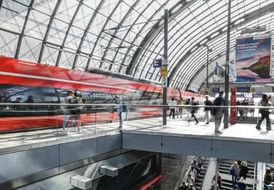Markets and strategy
Demand in passenger and freight transport has increased significantly over the last few years and has led to a higher intensity of use of the infrastructure. Growth in demand in freight transport and a significantly higher traffic volume in passenger transport, and therefore a further increase in capacity requirements, are expected.
By developing infrastructure in line with customer and market requirements, we want to enable the entire rail transport sector to take advantage of growth potential. The Strong Rail strategy incorporates DB Netze Track’s key strategic issues with this target in mind. As a capacity manager, DB Netze Track intends to create the infrastructural and operational conditions for the implementation of the Strong Rail strategy. The objective is to operate a highly condensed and highly efficient network that is to be ensured through systematic renovation, targeted upgrading and the perspective expansion of network capacity. This is also supported by DB Netze Track’s targeted implementation of Digital Rail for Germany, the improvement of the organization’s performance capability and improved use and availability of existing capacities. In order to achieve the objectives, DB Netze Track’s strategy essentially comprises the three strategic areas of the Strong Rail strategy:
- More robust: Through the renewal, digitalization and expansion of the infrastructure in line with requirements, we are looking to increase network capacity in corridors and hubs in order to eliminate existing bottlenecks and to be able to provide the necessary capacity for service expansions. This counteracts the overloading and aging of the infrastructure and enables greater reliability and growth on the rails. The central element of the strategy is the development of a high-performance network, which aims to improve the customer experience and ability to plan the capital expenditure measures, as well as boosting the reliability and performance of the infrastructure. The stated goal is to develop the highly utilized network into a high-performance network by 2030 through a general modernization of the most important rail corridors and thus make it a bedrock of stability for the rail system. There are several new and crucial elements here. For example, the construction work is to be consolidated in order to keep one line almost free of construction for many years after a closure. In order to minimize the capacity restrictions, highly condensed and efficient construction procedures are implemented. In addition, as part of the renewal work, preparatory work is already being carried out, where possible, for the implementation of Digital Rail for Germany, meaning the lines will be made ready for electronic interlockings/digital interlockings and the implementation of Digital Rail for Germany. The infrastructure, which will be more reliable and efficient after the general modernization and digitalization, is intended, alongside other measures, to contribute to an increase in operating quality and to enable initial capacity increases until the full effects of the new construction and expansions measures on capacity take effect. This also includes the further development of the new management philosophy, which focuses on utilization of capacity. When the targets are reached, greater transparency about available capacities and the prevention of overloading will allow for a further increase in performance capability. In order to implement these projects and overcome the challenges of the future, we recruit and train relevant skilled employees in a targeted manner. This also includes measures to modernize working methods and work equipment and to increase employer attractiveness.
- More efficient: We are implementing various measures, including lean excellence and digitalization, which should lay the foundations for effective and stable processes oriented towards the customer and enable efficient
organization. - More modern: DB Netze Track performs supporting tasks for issues concerning Germany in sync and European corridors. Rising robustness and therefore increasing capacity are key prerequisites for this.
- Greener: Key levers in infrastructure on the path to a climate-neutral future include the further electrification of lines – including innovative approaches such as overhead wire islands and the redesign of our own production processes. From 2023 onwards, we are focusing on sustainable vegetation management and the operation of glyphosate-free rail traffic in Germany, environmental protection measures such as bee cultivation on train-paths, resource protection through initiatives to promote circular economy approaches and noise reduction. In addition, measures are being implemented to reduce greenhouse gas emissions, for example in building management.


